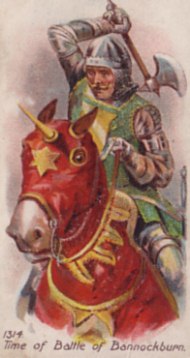Following the killing of an English sheriff by William Wallace, revolts broke out in Scotland and on 11th September at the Battle of Stirling Bridge, Wallace defeated English forces led by John de Warenne. The following month the Scots raided northern England...Wallace was appointed Guardian of Scotland in March; however in July Edward invaded again and defeated the Scottish army, led by Wallace at the Battle of Falkirk. Following the battle Wallace went into hiding...Further campaigns by Edward in 1300 and 1301, led to a truce between the Scots and English. (Read more.)
Is this the face of Robert the Bruce? From LJMU:
Scientists and historians have joined forces to create detailed virtual images of what could be the head of Robert the Bruce, reconstructed from the cast of a human skull held by the Hunterian Museum. The realistic images are the outcome of a collaboration between historians from the University of Glasgow and craniofacial experts from Liverpool John Moores University.
One image depicts the subject in his prime, a large and powerful male head that would have been supported by a muscular neck and stocky frame – a match for the super-athletes of today. This was a privileged individual who enjoyed the benefits of a first-class diet, and whose physique would have equipped him for the brutal demands of medieval warfare.
Robert Bruce, hero-king of Scots from 1306 until his death in 1329 aged around 55, was no stranger to the battlefield. He waged war to wear down his Scottish opponents and the English regime in Scotland, culminating in the battle of Bannockburn in 1314. To legitimise his kingship and free his kingdom, Bruce also campaigned in northern England and Ireland.
ShareHowever, the second image reveals that strength co-existed with frailty. The skull exhibits likely signs of leprosy, disfiguring the upper jaw and nose. Historians believe Bruce suffered from an unidentified ailment, possibly leprosy, which laid him low several times during his reign, and probably killed him. In Ulster in 1327, he was said to be so weak that he could only move his tongue.
The project to put a face to the Hunterian skull was led by Dr Martin MacGregor, a senior lecturer in Scottish history at the University of Glasgow. Dr MacGregor was inspired by the discovery of the skeleton of King Richard III of England beneath a car park in Leicester in 2012. Dr MacGregor requested the expertise of Professor Caroline Wilkinson, Director of LJMU’s Face Lab and a world-renowned craniofacial identification expert, to carry out the facial reconstruction of Robert the Bruce. Professor Wilkinson was also responsible for the facial reconstruction of Richard III. (Read more.)



















No comments:
Post a Comment